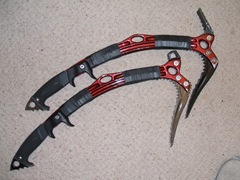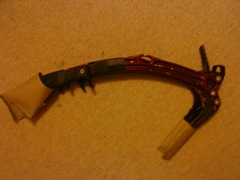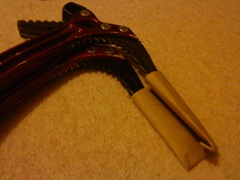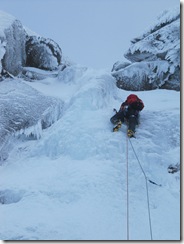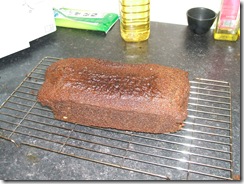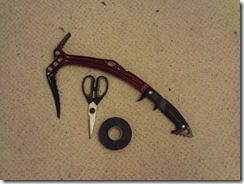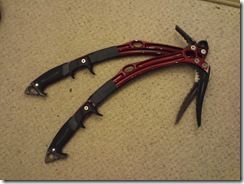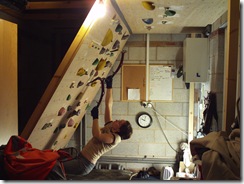Climbing ice or mixed routes with a pair of ice axes is an exhilarating and fulfilling experience, but should something go seriously wrong, say for instance you drop an axe, it can go from being fun and challenging to serious and terrifying in a matter of seconds.
I’m not going to talk about the differences between climbing leashed or leashless, as for me it is a no brainer – I am very firmly in the leashless camp. That said, I do own a set of clipper leashes for my axes, but I somehow doubt they will ever really be used again…

I used to use my clipper leashes in scotland in winter on mixed routes where, if I did somehow drop an axe things really wouldn’t be good. So they were more for tool security than my own (I’d rather shake out when I’m pumped than simply hang all my weight from my wrist loops). On a trip to Cogne climbing frozen waterfalls and deciding to try out the clipper leashes whilst seconding a WI4+, I discovered just what a pain in the butt they can be – I got pumped simply trying to detach from the axes to remove the ice screws. Ok so I’m sure I would get used to the clipper system through use and wouldn’t feel so much like no sooner had I unclipped, I would then proceed to dislodge my axe and send it plummeting down into the void, but, why would I bother? Why would I try to get used to a system I don’t particularly like when there are much better options?
And so we get to the meat of the post. Leashless lanyards.
On that same Cogne trip, the evening after my little escapade with the leashes, I decided there and then that I wasn’t going to wear them on anything steep where I felt I could knock an axe down. So how would I stop them being easily droppable? I took a length of 7mm tat out of my bag and tied two cord lanyards.
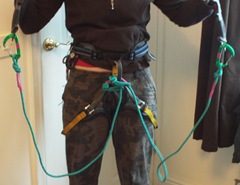
Now, these lanyards worked brilliantly. Long enough that you could still swing at full stretch, and pretty unobtrusive on steep ice. They did have one major shortcoming however: on anything less than vertical they dangle round your knees providing a very real tripping hazard (especially dire in easy angled gullies), so my thoughts shifted to the new type of ‘spring leash’ systems now being made by both Grivel and Black Diamond.
Now, me being both skint and keen on anything I can make myself, I decided initially that I would make my own version using 16mm tubular webbing and shock-cord, but an epic evening spent not being able to get the cord far enough through the webbing (a problem that could be worked around I’m sure) led me to want to have a proper look at the commercial systems, to see whether I really was wasting my time for very little saving.
I had a look at the Grivel Double Spring Leash and the Black Diamond Spinner Leash, making comparisons of their respective advantages as I played around in the shops making myself look like a deranged idiot:
Grivel Double Spring
- Available with or without crabs
- Supplied crabs feel less crappy to me than the BDs
- Less tension than the Black Diamond meaning they are less obstructive to your axe swing
- Cheaper (buying without crabs makes it significantly cheaper than the BD)
- Same strength rating as the Grivel (rated to 2kn, equivalent to the 200kg claimed by the Grivel)
- Very snazzy looking and innovative springy webbing stuff
- Captive crabs (for some these would be an advantage, even though I don’t like them)
- In-built very neat little swivel, meaning that tangles are completely avoidable
I bought a set of the Grivel Double Springs, without the supplied crabs (£15 without and £25 with) – I had my own 400kg rated ‘accessory crabs’ I bought a while back (when I was thinking about making my own clipper leashes, but I digress), which, seeing as the spring leash itself is only claimed to hold 200kg, are perfect. Sadly I can’t seem to find these little crabs in the shops again anywhere as I’d like to buy a few more.
So, yes, I bought the cheapest ones. I really like the swivel on the Black Diamond, but am not prepared to pay £40 for them, just for that, especially when I can self-engineer my own version (it’s the best of all worlds, mwahahaha!).
A tiny bit of effort later and here we have it, the Grivel with a Swivel.

The swivel is a 6mm stainless steel captive eye swivel shackle, bought for about £3-4 from a sailing chandlery (incidentally the swivel itself has a SWL of 1tonne – meaning that it could probably be shock loaded with a force equal to about 5 times that without breaking), larksfooted into the leashes and with a short length of 4mm accessory cord tied through the other side to attach to my harness or wherever I decide to attach. Ok so the swivel is definitely heavier than BD’s offering, but significantly cheaper and stronger. I will detach it and leave it behind when I want to go super lightweight (i.e. Alpine climbing) – an option the BD simply doesn’t offer you.
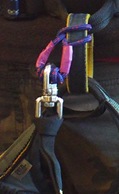
To say I am pleased with these is an understatement – for me, this is pretty much the perfect system. That is, until I find an even smaller and lighter swivel capable of fitting my needs.
